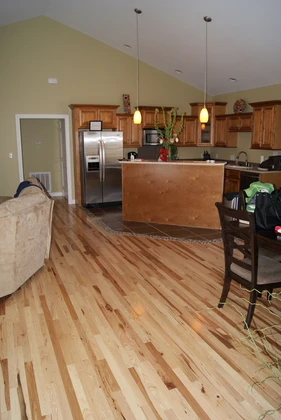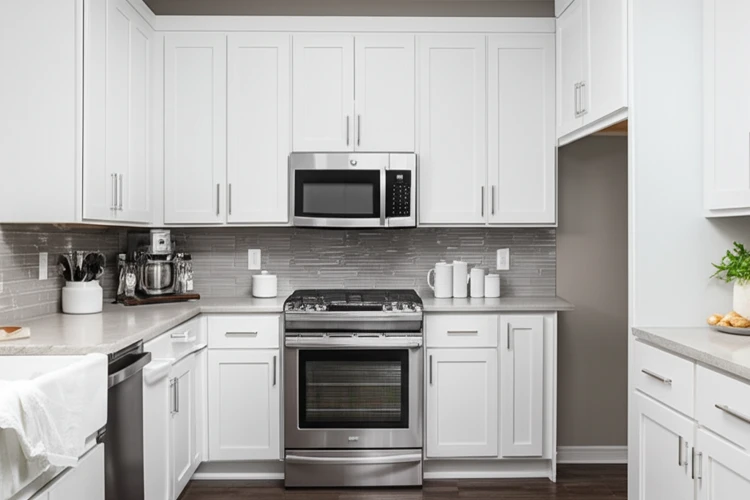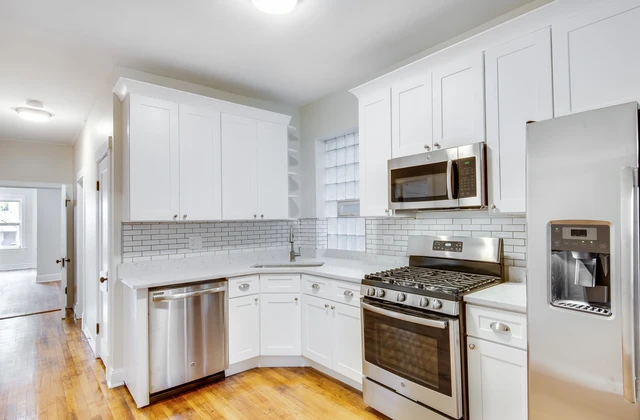Disclaimer: As an Amazon Associate, I earn commission from qualifying purchases.
Wood floors have long been a staple in home decor, particularly in kitchens, where their timeless appeal and practicality shine. With over a decade of experience in home decor and kitchen design, I can attest to the enduring charm and functionality of wood floors. This comprehensive guide will delve into the benefits, types, installation, maintenance, and design considerations of wood floors in a kitchen, all backed by credible sources and industry best practices.
The Appeal of Wood Floors in a Kitchen
Wood floors offer a unique blend of aesthetic and functional benefits. Their natural beauty can enhance any kitchen design, from traditional to modern. Durability is another key advantage; hardwood floors can last for decades with proper care. According to a report by the National Wood Flooring Association, wood floors can last up to 100 years, far outlasting other flooring materials like vinyl or laminate.
However, it’s important to consider both the pros and cons. While wood floors are beautiful and durable, they can be susceptible to moisture damage and scratches. Regular maintenance is essential to keep them looking their best.
Types of Wood Floors Suitable for Kitchens
There are several types of wood floors that are well-suited for kitchens, each with its unique characteristics and benefits:
Hardwood Floors
Hardwood floors are the classic choice, offering unparalleled natural beauty and durability. They come in various species like oak, maple, and walnut, each with its distinct grain and color. Hardwood floors can be refinished multiple times, extending their lifespan significantly.
Engineered Wood Floors
Engineered wood floors are made of multiple layers of wood, with a real wood veneer on top. They are more resistant to moisture and temperature changes, making them a great option for kitchens. Engineered wood can also be refinished, though not as many times as solid hardwood.
Bamboo Floors
Bamboo floors are an eco-friendly alternative to traditional hardwood. They are highly durable and resistant to moisture, making them ideal for kitchens. Bamboo is also a rapidly renewable resource, adding to its sustainability appeal.
Considerations for Choosing Wood Floors in a Kitchen
When choosing wood floors for your kitchen, several key considerations should guide your decision:
Moisture Resistance
Kitchens are prone to spills and high humidity, so choosing a wood floor with good moisture resistance is crucial. Engineered wood and bamboo are excellent options in this regard.
Maintenance Requirements
Wood floors require regular cleaning and occasional refinishing to maintain their appearance. Consider the time and effort you’re willing to invest in maintenance before making a decision.
Durability
Kitchens are high-traffic areas, so durability is essential. Hardwood and bamboo are known for their strength and can withstand heavy use.
Step-by-Step Guide to Installing Wood Floors in a Kitchen
Installing wood floors in a kitchen can be a DIY project with the right tools and knowledge. Here’s a step-by-step guide:
Tools Needed
- Floor nailer or stapler
- Circular saw
- Jigsaw
- Tape measure
- Chalk line
- Safety gear (gloves, goggles, ear protection)
Preparation
Begin by measuring the kitchen and purchasing enough material to cover the area, plus an extra 10% for waste. Ensure the subfloor is clean, dry, and level.
Installation Steps
- Lay down a moisture barrier if needed.
- Start installing the planks from one corner of the room, ensuring the first row is straight.
- Use spacers to maintain a consistent gap between the planks and the wall.
- Stagger the joints for a more stable and visually appealing finish.
- Use a floor nailer or stapler to secure the planks to the subfloor.
- Continue laying the planks, ensuring each row is tightly fitted.
- Trim the last row to fit and install baseboards to cover the expansion gap.
Safety Tips
Wear appropriate safety gear and follow manufacturers’ guidelines for using power tools. Ensure proper ventilation when applying finishes or adhesives.
Maintenance Tips for Wood Floors in a Kitchen
Proper maintenance is key to keeping wood floors looking their best. Here are some best practices:
Cleaning Techniques
Use a soft-bristled broom or a vacuum with a hard floor attachment to remove dirt and debris. For deeper cleaning, use a wood floor cleaner recommended by the manufacturer. Avoid using water or steam, as they can damage the wood.
Spill Management
Wipe up spills immediately to prevent water from seeping into the wood. Use a dry cloth or paper towel to blot the area, then clean with a wood floor cleaner if necessary.
Preventive Measures
Place mats at entry points to reduce the amount of dirt and moisture tracked into the kitchen. Use area rugs in high-traffic areas to protect the floor from wear and tear.
Enhancing Kitchen Efficiency with Wood Floors
Wood floors can enhance kitchen efficiency in several ways. They provide a comfortable surface for standing, which is essential for tasks like cooking and meal prep. The natural warmth of wood also makes the kitchen feel more inviting, encouraging more time spent in the space.
Compared to other flooring options like tile, wood floors offer better traction, reducing the risk of slips and falls. They also absorb sound, creating a quieter environment.
Sustainability and Wood Floors in a Kitchen
Sustainability is an important consideration for many homeowners. Wood floors can be a highly sustainable choice, especially when sourced responsibly. Look for wood floors certified by the Forest Stewardship Council (FSC), which ensures the wood comes from well-managed forests.
Reclaimed wood is another eco-friendly option. It repurposes old wood, reducing waste and conserving natural resources. Sustainable forestry practices, such as selective harvesting and replanting, also contribute to the environmental friendliness of wood floors.
Design Ideas for Wood Floors in a Kitchen
Wood floors can complement a variety of kitchen styles. Here are some design ideas:
Modern Kitchens
For a modern look, opt for light-colored wood floors with a smooth finish. Pair them with sleek cabinets and stainless steel appliances for a cohesive design.
Rustic Kitchens
Rustic kitchens benefit from darker, more textured wood floors. Reclaimed wood or hand-scraped finishes add character and warmth to the space.
Traditional Kitchens
Traditional kitchens can be enhanced with classic hardwood floors in medium tones. Intricate patterns like herringbone or chevron can add a touch of elegance.
Cost Considerations for Wood Floors in a Kitchen
The cost of wood floors can vary significantly depending on the type of wood, quality, and installation method. Hardwood floors typically range from $8 to $15 per square foot, while engineered wood and bamboo can be slightly less expensive.
Initial investment is just one part of the cost equation. Wood floors also require regular maintenance, which can add to the long-term costs. However, the durability and potential return on investment (ROI) make wood floors a worthwhile investment for many homeowners. According to a study by the National Association of Realtors, homes with wood floors often sell for more and faster than those without.
Common Challenges and Solutions
While wood floors offer many benefits, they also come with challenges. Here are some common issues and solutions:
Moisture Damage
Moisture can cause wood floors to warp or buckle. To prevent this, ensure proper ventilation and use area rugs to absorb spills. Regularly check for leaks and address them promptly.
Scratches
Scratches are a common issue with wood floors. Use furniture pads to prevent scratches from moving furniture. Regularly sweep or vacuum to remove dirt and debris that can scratch the surface.
Fading
Sunlight can cause wood floors to fade over time. Use window treatments to block direct sunlight and consider rotating area rugs to even out fading.
Frequently Asked Questions (FAQs)
Are wood floors suitable for high-traffic kitchens?
Wood floors can be suitable for high-traffic kitchens, but durability varies by type. Hardwood and bamboo are particularly resilient. Regular maintenance, such as sweeping and occasional refinishing, can help prolong their lifespan.
How do wood floors compare to tile in a kitchen?
Wood floors offer a warmer, more inviting feel compared to tile. They also provide better traction, reducing the risk of slips. However, tile is more resistant to moisture and stains, making it a low-maintenance option.
Can wood floors be refinished if damaged?
Yes, wood floors can be refinished if damaged. The process involves sanding down the surface to remove scratches and stains, then applying a new finish. The cost can vary but typically ranges from $1.50 to $4 per square foot.
Are there any eco-friendly wood floor options?
Yes, there are several eco-friendly wood floor options. Look for FSC-certified wood or reclaimed wood, which is repurposed from old buildings or furniture. Bamboo is another sustainable choice due to its rapid renewability.
What is the average lifespan of wood floors in a kitchen?
The average lifespan of wood floors in a kitchen can vary, but with proper care, they can last for decades. Hardwood floors can last up to 100 years, while engineered wood and bamboo have a slightly shorter lifespan but are still highly durable.
Can I install wood floors myself?
Installing wood floors can be a DIY project with the right tools and knowledge. However, it requires careful planning and execution. If you’re not confident in your skills, hiring a professional installer is recommended to ensure a high-quality finish.
Conclusion
Wood floors are a timeless and practical choice for kitchens, offering a blend of natural beauty and durability. By understanding the different types of wood floors, their maintenance requirements, and design considerations, you can make an informed decision that enhances your kitchen’s efficiency and aesthetics. Whether you opt for classic hardwood, engineered wood, or eco-friendly bamboo, wood floors can add value and warmth to your home for years to come.







